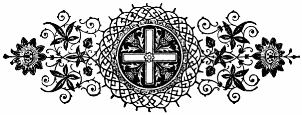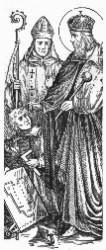
Saint Stephen, King of Hungary
|

Saint Stephen, King of Hungary![]() September 2nd
September 2nd ![]()
First King of Hungary, b. at Gran, 975; d. 15 August, 1038. He was a son of the Hungarian chief Géza and was baptized, together with his father, by Archbishop St. Adalbert of Prague in 985, on which occasion he changed his heathen name Vaik (Vojk) into Stephen. In 995 he married Gisela, a sister of Duke Henry of Bavaria, the future Emperor St. Henry II, and in 997 succeeded to the throne of Hungary. In order to make Hungary a Christian nation and to establish himself more firmly as ruler, he sent Abbot Astricus to Rome to petition Pope Sylvester II for the royal dignity and the power to establish episcopal sees. The pope acceded to his wishes and, in addition, presented him with a royal crown with which he was crowned at Gran on 17 August, 1001. He founded a monastery in Jerusalem and hospices for pilgrims at Rome, Ravenna, and Constantinople. He was a personal friend of St. Bruno of Querfurt and corresponded with Abbot St. Odilo of Cluny. The last years of his life were embittered by sickness and family troubles. When on 2 September, 1031, his only son, St. Emeric, lost his life on a bear hunt, his cherished hope of transferring the reins of government into the hands of a pious Christian prince were shattered. During his lifetime a quarrel arose among his various nephews concerning the right of succession, and some of them even took part in a conspiracy against his life. He was buried beside his son at Stuhlweissenburg, and both were canonized together in 1083. His feast is on 2 September, but in Hungary his chief festival is observed on 20 August, the day on which his relics were transferred to Buda. His incorrupt right hand is treasured as the most sacred relic in Hungary.

Three old lives are extant: Vita major in Mon. Germ. Hist., Script., XI, 229-39, written probably before 1083; Cronica Ungarorum in Mon. Pol. hist., I, 495-515, written about 1086; Vita minor in Mon. Germ. Hist., Script., XI, 226-9, written about 1100. Another Life written by HARTWIG shortly after the Vita minor in Script. rerum Hung., I, 413-28, is based on the three preceding ones. KARACSONYI, Szent Istvan kiraly elete (Budapest, 1904); IDEM, Szent Istvan kiraly okleveley es a Szilveszter bulla (Budapest, 1894); HORN, St. Etienne, roi apostolique de Hongrie (Paris, 1899); STILTING, Vita s. Stephani regis Hungarioe (Raab, 1747; Kaschau, 1767); BUTLER, Lives of the Saints, 2 September; BARING-GOULD, Lives of the Saints, 2 September.
The Catholic Encyclopedia, Volume XIV
Nihil Obstat, July 1, 1912, Remy Lafort, S.T.D., Censor
Imprimatur. +John Cardinal Farley, Archbishop of New York
|
|